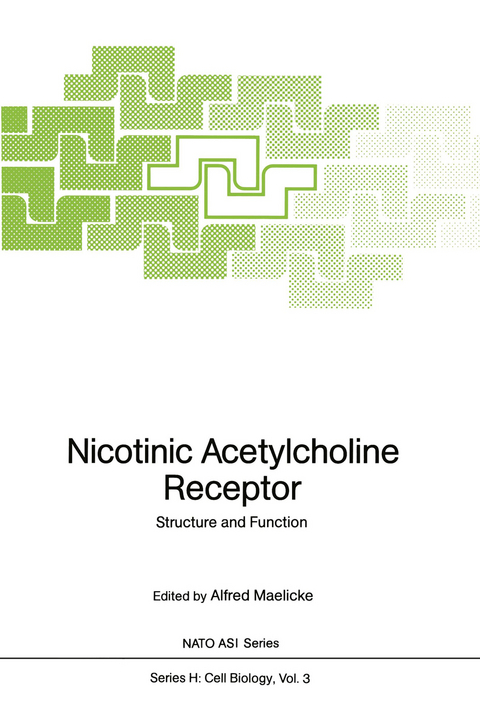
Nicotinic Acetylcholine Receptor
Springer Berlin (Verlag)
978-3-642-71651-5 (ISBN)
The most critical event in chemical cell to cell communications is the conversion of the chemical signal into the primary response of the receiving cell. In the case of cholinergic cell to cell communication, i. e. in cholinergic nerve-nerve and nerve muscle systems, a single molecule, namely the nicotinic acetyl choline receptor is responsible for both signal reception and primary response: Through binding of the neurotransmitter acetyl choline released from the associated nerve ending, the receptor receives the chemical message. Short-lived openings of the recep tor-integral ion channel constitute the initial reaction to this stimulation, i. e. the primary response. This integration of the receiving and the responsive unit into a single protein structure seems to be typical for transmi tter-acti vated ion channel pro teins of many excitable cells including those of the central ner vous system. Elucidation of the mechansim of action of the acetylcholine receptor is of interest, therefore, not only for cholinergic cell to cell communications but, even more impor tantly, as a general model for the less accessible neurotransmit ter receptors of the central nervous system. While the basic reactions in the, course of cholinergic cell to cell communication and the molecular components involved are rather well understood, a molecular mechanism for cholinergic ex ci tation has not yet been established.
Content.- I. Molecular Structure.- Three-Dimensional Structure of the Acetylcholine Receptor.- Ultrastructural Analysis of the Native Acetylcholine Receptor.- Probing Acetylcholine Receptors with Monoclonal Antibodies.- Acetylcholine Receptor Conformation Probed by Subunit-Specific Monoclonal Antibodies.- What can we Learn About the Acetylcholine Receptor from Synthetic Peptides?.- II. Biophysical and Biochemical Studies of AChR Topography.- Topography of the Acetylcholine Receptor as Revealed by Fluorescence Energy Transfer.- Infrared Studies of the Acetylcholine Receptor Structure.- Monoclonal Antibodies as Probes of Acetylcholine Receptor Function.- Antigenic Specificity of Monoclonal Antibodies Against Torpedo 93 and Human Acetylcholine Receptor, and Use of these Anti-bodies to Investigate Myasthenia gravis.- Tertiary Structure of the Nicotinic Acetylcholine Receptor Probed by Photolabeling and Protein Chemistry.- A Structural Model of the Ion Channel of the Nicotinic Acetylcholine Receptor.- III. Ligand Binding, Ion Flux Studies and Reconstitution.- A General Treatment of Ligand Binding to the Acetylcholine Receptor.- Lipid-Protein Interactions and Acetylcholine Receptor Function in Reconstituted Membranes.- Regulation of Intercellular Signal Transmission. New Approaches to Chemical Kinetic Measurements on Cell Surfaces.- Hysteresis and Channel Properties of the Acetylcholine Receptor from Torpedo Californica.- IV. Electrophysiological Studies.- States of the Nicotinic Acetylcholine Receptor: Enumeration, Characteristics and Structure.- Function of Mammalian Nicotinic Acetylcholine Receptors.- Single Channel Studies of Acetylcholine Receptors Covalently Alkylated with Acetylcholine.- Effects of Allosteric Ligands on the Gating of Single Channel Currents in BC3H-1 Cells.- On the Role of Trophic Factors vs. Muscle Activity in the Development of Acetylcholine-Receptor Ion Channels in Rat Endplates.- Molecular Electrophysiology of Cloned AChR Channels Expressed in Xenopus Oocytes.- V. AChR Associated Proteins.- The Transglutaminase of Acetylcholine Receptor Rich Membranes.- Association of the Postsynaptic 43K Protein with Sites of Clustered and Diffusely-Distributed Acetylcholine Receptor.- cAMP-Dependent Phosphorylation of the Nicotinic Acetylcholine Receptor: Characterization of the Protein Kinase in Torpedo Electric Organ, Lack of Correlation in Myotubes Between Increased Intracellular Levels of cAMP and Influx of Monovalent Ions, Block of Influx by Forskolin Independently of cAMP Levels.- Common Antigenic Determinants Between Acetylcholine Receptor and Protozoan Membranes.- VI. Ganglionic and Brain AChR.- Identification and Reconstitution of a Neuronal Acetylcholine Receptor from Insects.- Studies on the Nicotinic Cholinergic Receptor of Sympathetic Neurones.- Radioligand Labelling of Nicotinic Receptors in Mammalian Brain.- VII. Molecular Genetics.- Molecular Biology of Muscle and Neural Acetylcholine Receptors.- Molecular Biology of Nicotinic Acetylcholine Receptors from Chicken Muscle and Brain.- Acetylcholine Receptor Related Genes Expressed in the Nervous System.- Expression Cloning and Fusion Proteins as Tools to Study Receptor Structure.- Establishing a System for the Stable Expression of Torpedo Acetylcholine Receptors.- Characterization of the mRNA and the Gene of a Putative Neuronal Nicotinic Acetylcholine Receptor Protein from Drosophila.- VIII. Structural Models.- Review and Revision of Structural Models for the Transmembrane Portion of the Acetylcholine Receptor Channel.- A Structural and Dynamic Model for the Nicotinic Acetylcholine Receptor.- Authors Index.
| Erscheint lt. Verlag | 21.12.2011 |
|---|---|
| Reihe/Serie | Nato ASI Subseries H: |
| Zusatzinfo | XVIII, 492 p. |
| Verlagsort | Berlin |
| Sprache | englisch |
| Maße | 170 x 244 mm |
| Gewicht | 873 g |
| Themenwelt | Medizin / Pharmazie ► Medizinische Fachgebiete ► Pharmakologie / Pharmakotherapie |
| Medizin / Pharmazie ► Pharmazie | |
| Naturwissenschaften ► Biologie ► Humanbiologie | |
| Naturwissenschaften ► Biologie ► Zellbiologie | |
| Schlagworte | Cell • Muscle • nervous system • Neurotransmitter • Protein Structure |
| ISBN-10 | 3-642-71651-2 / 3642716512 |
| ISBN-13 | 978-3-642-71651-5 / 9783642716515 |
| Zustand | Neuware |
| Haben Sie eine Frage zum Produkt? |
aus dem Bereich


